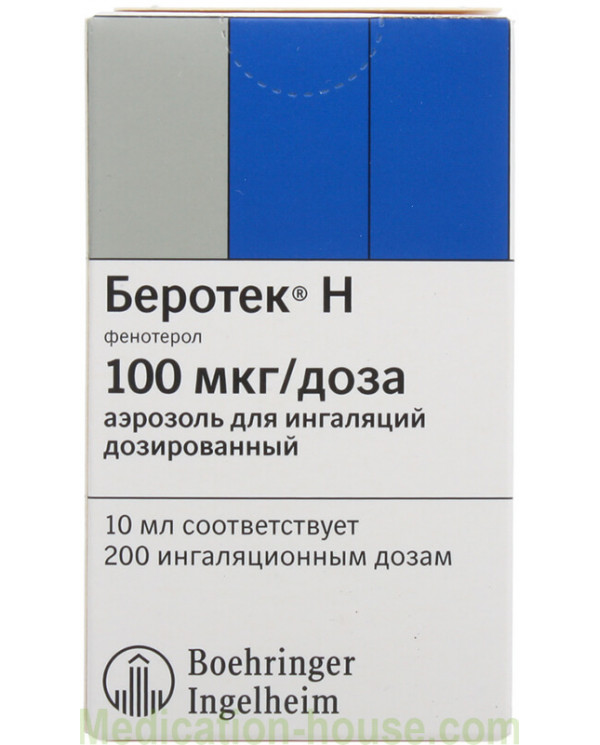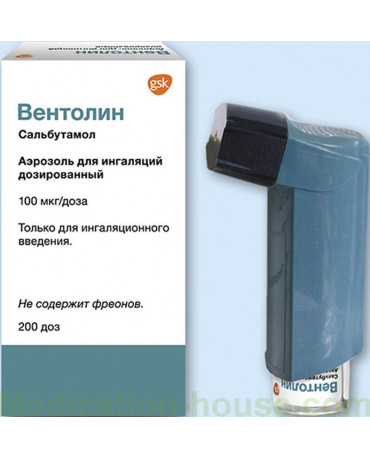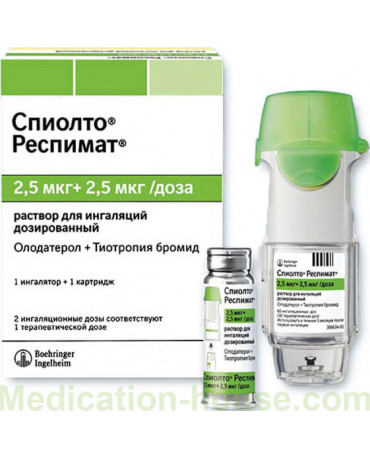Berotec N instruction
You can buy Berotec N here
Berotec N - selective beta2-adrenergic agonist, bronchodilating agent.
Release form and composition
Dosage form - metered-dose aerosol for inhalation: transparent, colorless or light yellow or light brown liquid, free of suspended particles [10 ml (200 doses) in metal aerosol cans equipped with a metering valve and mouthpiece; in a cardboard bundle 1 spray can and instructions for use Berotec N].
Composition of 1 inhaled dose of aerosol:
active substance: fenoterol hydrobromide - 100 mcg;
auxiliary components: purified water, tetrafluoroethane (HFA 134a, propellant), absolute ethanol, anhydrous citric acid.
Pharmacodynamics
Active ingredient Berotec N - phenoterol hydrobromide, is a selective beta2-adrenergic agonist, bronchodilator. The drug prevents and relieves bronchospasm attacks in case of bronchial asthma and other diseases accompanied by airway obstruction (chronic obstructive bronchitis, including with emphysema).
Fenoterol, used in the therapeutic dose range, is a selective stimulator of β2-adrenergic receptors. When using the drug in higher doses, β1-adrenergic receptors are stimulated.
Due to binding to β2-adrenergic receptors, adenylate cyclase is activated through a stimulatory Gs protein, and subsequently, the formation of cyclic adenosine monophosphate (cAMP) increases, which activates protein kinase A. Protein kinase A prevents the connection of myosin with actin, as a result of which smooth muscle relaxes.
Fenoterol relaxes the smooth muscles of the bronchi and blood vessels, and also protects against bronchoconstrictive stimuli such as allergens (early response), cold air, exercise, histamine and methacholine.
In addition, fenoterol inhibits the release of pro-inflammatory and bronchoconstrictor mediators from mast cells. After the use of phenoterol in a dose of 600 μg, an increase in mucociliary clearance was noted.
Having a stimulating effect on β1-adrenergic receptors, phenoterol (especially at higher doses than therapeutic) can have an effect on the myocardium, causing increased and increased heart rate.
The drug quickly stops bronchospasm of various origins. The bronchodilation effect develops within a few minutes after inhalation and lasts for 3-5 hours.
Pharmacokinetics
Depending on the inhalation system used and the lower respiratory tract inhalation technique, approximately 10–30% of phenoterol hydrobromide is reached, the rest of the drug settles in the mouth and upper respiratory tract, and is then swallowed.
After inhalation of Berotec N, the absolute bioavailability of phenoterol is 18.7%.
The absorption of the drug from the lungs occurs in two phases: 30% of the dose is absorbed rapidly with a half-life (T½) of 11 minutes, 70% - slowly with T½ of 120 minutes.
The maximum plasma concentration (Cmax) of phenoterol after inhalation at a dose of 200 μg is 66.9 pg / ml and is reached within 15 minutes.
With the oral administration of fenoterol hydrobromide, approximately 60% of the dose is absorbed. The absorbed amount of the substance undergoes an extensive first phase of metabolism in the liver. Thus, the oral bioavailability is about 1.5%, and its contribution to the plasma concentration of the drug after inhalation is small.
40–55% binds to plasma proteins. After intravenous (iv) administration of the drug, the distribution of fenoterol in plasma is adequately described by a 3-component pharmacokinetic model with T½ 0.42 min, 14.3 min and 3.2 h. After iv administration, the volume of distribution (Vd) of fenoterol at equilibrium the concentration is 1.9–2.7 l / kg.
Fenoterol can pass through the placental barrier and excreted in breast milk.
The drug is extensively metabolized in the liver by conjugation to glucuronides and sulfates. Part of fenoterol that gets into the gastrointestinal tract is metabolized primarily by sulfation, and the onset of metabolic activation of the starting substance occurs already in the intestinal wall.
Phenoterol is excreted in the form of inactive sulfate conjugates with urine and bile. Biotransformation undergoes the bulk of the dose (approximately 85%). About 15% of the average total clearance of a systemically available dose is excreted in urine. The volume of renal clearance indicates tubular secretion of the drug in addition to glomerular filtration.
After inhalation use unchanged, 2% of the dose is excreted through the kidneys within 24 hours.
Indications for use
diseases accompanied by reversible airway obstruction, including chronic obstructive pulmonary disease and chronic bronchitis;
attacks of bronchial asthma;
prevention of asthma attacks during physical exertion.
Contraindications
Absolute:
hypertrophic obstructive cardiomyopathy;
tachyarrhythmia;
children under 4 years old;
hypersensitivity to any component of the drug.
Relative (Berotec N aerosol, especially in high doses, can be used only after assessing the ratio of benefits and risks):
insufficiently controlled diabetes mellitus;
hypokalemia;
hyperthyroidism;
pheochromocytoma;
severe organic diseases of the heart and blood vessels: severe lesions of the peripheral and cerebral arteries, coronary artery disease, coronary heart disease, heart defects (including aortic stenosis), chronic heart failure;
recently suffered myocardial infarction (in the previous 3 months);
pregnancy and lactation;
children's age 4–6 years;
simultaneous use of monoamine oxidase inhibitors (MAO), tricyclic antidepressants.
Berotec N, instructions for use: method and dosage
Aerosol Berotec N is applied by inhalation. 1 dose = 1 injection.
Recommended dosage regimens Berotec N for adults and children from 6 years:
attacks of bronchial asthma and diseases with reversible obstruction of the airways: 1 dose for the development of an attack. After 5 minutes, inhalation can be repeated if breathing relief has not occurred. If after 2 inhalations the effect is absent, you should immediately consult a doctor. During the day, you can use no more than 8 inhalation doses;
prevention of asthma attacks of physical stress: 1-2 doses before exercise, but not more than 8 doses per day.
Dosage regimen Berotec N for children 4-6 years:
attacks of bronchial asthma and diseases with reversible obstruction of the airways: 1 dose for the development of an attack. If there is no effect, you should immediately consult a doctor;
prevention of asthma attacks of physical stress: 1 dose before exercise, but not more than 4 doses per day.
Achieving maximum effect is possible only with the correct use of the inhaler. To prepare a new inhaler for use, remove the protective cap, turn the balloon upside down and double-click on its bottom (make two injections into the air). A single injection into the air must be done if the inhaler has not been used for more than 3 days.
The following rules should be observed with each use of Berotec N:
Remove the protective cap.
Take a full exhale.
Holding the can upside down, tightly grasp the mouthpiece with your lips.
Take the deepest breath possible and at the same time press firmly on the bottom of the balloon to release one inhaled dose. Hold your breath for a few seconds, take out the mouthpiece and exhale slowly.
If several doses are prescribed, repeat the steps described in paragraphs 2–4.
To put on a protective cap.
The can is not transparent, so it is impossible to visually determine whether it is empty. Each cylinder is designed for 200 doses, but after their use may contain some more amount of the drug. It can not be used, since in this case there is a risk that the patient will not be able to receive the therapeutic dose he needs.
The amount of the drug remaining in the bottle can be roughly determined as follows: remove the protective cap, immerse the bottle in a container of water and look at its position. If the balloon floats on the surface of the water, leaning to one side, it is empty; floats upside down and leaned slightly to the side - contains ¼ of the aerosol; floats upside down strictly vertically - contains ½; drowned - contains ¾.
At least once a week, the inhaler must be cleaned. The mouthpiece must be clean so that the aerosol does not accumulate and does not block spraying.
Rules for cleaning the inhaler:
Remove the cap and remove the can from the inhaler.
Rinse the inhaler body with warm water.
Shake the inhaler of the remaining water and let it air dry. Do not use heating devices!
Insert the cylinder and put on the protective cap.
The plastic mouthpiece serves as a dispenser of the drug and is designed specifically for Berotec N. aerosol. It can not be used with other aerosols; it is also forbidden to use other adapters for dispensing Berotec N.
The aerosol in the cylinder is under pressure. The cylinder must not be heated above 50 ° C and attempted to open.
Side effects
from the respiratory system: often (from ≥ 1/100 to <1/10) - cough; infrequently (from ≥ 1/1000 to <1/100) - paradoxical bronchospasm; the frequency is unknown (there is insufficient data to determine the frequency of the development of effects) - irritation of the larynx and pharynx;
from the cardiovascular system: infrequently - arrhythmia; frequency unknown - decrease in diastolic blood pressure (BP), increased systolic blood pressure, palpitations, tachycardia, myocardial ischemia;
from the digestive system: infrequently - nausea, vomiting;
from the musculoskeletal system: the frequency is unknown - muscle weakness, muscle spasm, myalgia;
from the psyche and nervous system: often - tremor; infrequently - excitement; frequency unknown - dizziness, headache, nervousness;
from the side of metabolism: infrequently - hypokalemia (including severe);
from the immune system: frequency is unknown - urticaria, hypersensitivity;
on the part of the skin and subcutaneous tissues: infrequently - itching; frequency unknown - skin reactions (including rash), hyperhidrosis.
Overdose
The main symptoms of an overdose are caused by excessive beta-adrenergic stimulation: a decrease or increase in blood pressure, an increase in pulse pressure, a heartbeat, arrhythmias, tachycardia, angina pectoris, tremor, and facial flushing. Hypokalemia and metabolic acidosis are also possible.
In case of an overdose, Berotec N is canceled. The patient is prescribed sedatives, in severe cases, intensive symptomatic therapy is performed. It is necessary to control the balance of electrolytes and acid-base balance.
As specific antidotes, beta-blockers (preferably selective beta1-blockers) may be used. However, caution is required in selecting the dose of these drugs, since increased bronchial obstruction is possible.
special instructions
The use of Berotec N for the relief of asthma attacks (for symptomatic therapy) is more preferable than regular use of the drug.
Patients should be examined to establish the need for prescribing or strengthening anti-inflammatory treatment (e.g., inhaled glucocorticosteroids) to control airway inflammation and prevent delayed lung damage.
With increased bronchial obstruction, it is forbidden to increase the frequency of inhalation Berotec N and its use in doses exceeding those prescribed by the doctor. This can be dangerous, because the need for regular use of β2-adrenergic agonists can be a sign of poor control of the disease. In this case, a review of the treatment plan is required, especially the adequacy of the anti-inflammatory therapy in order to avoid the development of a potentially life-threatening worsening of disease control.
Like any inhalation agent, Berotec N can cause a potentially life-threatening paradoxical bronchospasm. In this case, you must immediately cancel the drug and prescribe alternative therapy.
Patients should immediately seek medical attention if acute, rapidly developing shortness of breath occurs.
Sympathomimetics, including Berotec N, can cause effects on the part of the cardiovascular system. There are rare reports of the development of myocardial ischemia. Patients with concomitant severe heart diseases (for example, with arrhythmia, severe heart failure or coronary heart disease) should be warned about the need for urgent medical attention in case of chest pain or worsening of the course of cardiovascular disease.
Particular attention should be paid to symptoms such as chest pain and shortness of breath, as they can be either cardiac or respiratory in nature.
During therapy with beta2-agonists, the development of potentially serious hypokalemia is possible. Caution should be exercised in patients with severe bronchial asthma, since their hypokalemia can be aggravated by the action of simultaneously used glucocorticosteroids, diuretics, xanthine derivatives. In addition, concomitant hypokalemia hypoxia can enhance its effect on heart rate. In patients receiving digoxin, due to hypokalemia, an increase in predisposition to arrhythmias is possible. In such cases, control of serum potassium levels is required.
During the use of Berotec N in studies on drug abuse for non-medical reasons, it is possible to obtain positive test results for the presence of fenoterol, which is important, for example, for athletes (doping control).
It is necessary to take into account a small amount of ethanol in the composition of Berotec N aerosol: in 1 dose - 15,597 mg.
The simultaneous use of other sympathomimetic bronchodilators is allowed only as prescribed by the doctor and under his strict supervision.
Berotec N can be used in combination with anticholinergic bronchodilators.
Influence on the ability to drive vehicles and complex mechanisms
Special studies on the effect of Berotec N on the psychophysical functions of humans have not been conducted. However, in clinical studies, rare cases of dizziness have been reported. In this regard, it is recommended to observe safety precautions when driving vehicles and performing potentially dangerous types of work.
Pregnancy and lactation
In preclinical and clinical studies, there was no negative effect of phenoterol on pregnancy and fetal development. Nevertheless, during pregnancy (especially in the first trimester) Berotec N should be used only as directed by a doctor who will assess the degree of correlation of the expected benefit and possible risks. It is important to consider that the drug can have an inhibitory effect on the contractile activity of the uterus.
Preclinical studies have found that fenoterol is excreted in mother's milk, but its effect on the development of the infant has not been studied. In this regard, during lactation, Berotec N is used only if the benefit is higher than the possible risks.
Clinical studies on the effects of fenoterol on fertility have not been conducted. In preclinical studies, there was no adverse effect of the drug on childbearing function.
Use in childhood
Berotec N is contraindicated in children under 4 years of age. The clinical experience of using the drug in children 4-12 years old is limited, therefore, at this age, treatment is carried out with caution, under the close supervision of a doctor and adult supervision.
Drug interaction
Glucocorticosteroids, anticholinergics, beta-adrenergic agonists, diuretics, xanthine derivatives (e.g., theophylline), and cromoglicic acid can enhance side effects of phenoterol.
Beta-blockers can significantly weaken the bronchodilator effect of fenoterol.
Tricyclic antidepressants and MAO inhibitors are able to enhance the effects of β-adrenergic agonists, therefore, they should be used with caution when using bronchodilators.
Inhalation anesthetics (for example, enflurane, trichlorethylene, halothane) increase the risk of phenoterol affecting the cardiovascular system.
Hypokalemia developed under the influence of Berotec N can be enhanced by corticosteroids, diuretics, xanthine derivatives. Of particular clinical significance is the phenomenon for patients with severe airway obstruction.
Terms and conditions of storage
Keep out of the reach of children, where the temperature does not exceed 25 ° C.
Shelf life is 3 years.
Reviews
Patients leave positive feedback on Berotec N, noting its effectiveness and rapid action in attacks of bronchial asthma and airway obstruction.
Terms of sell
You don't need a prescription to buy Berotec N.



